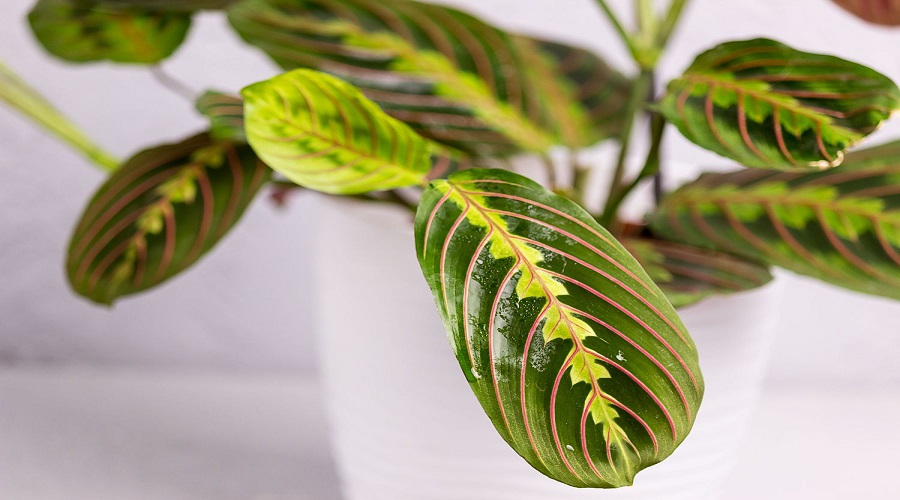Prayer plants are fascinating houseplants known for their unique leaf movements. They come in various shapes, sizes, and colors, making them popular choices for indoor gardens. Understanding these plants begins with learning about their origins and appearance.
Origins and Appearance
Prayer plants originate from the tropical regions of South and Central America, where they thrive in the warm, humid climates of rainforests. They belong to the Marantaceae family and are scientifically known as Maranta, Calathea, and Stromanthe species.
These plants are prized for their striking foliage, featuring intricate patterns, vibrant colors, and often, contrasting veins. The leaves are typically oval-shaped or lanceolate, with some species displaying elongated or rounded forms. Prayer plants are renowned for their ability to move their leaves, a phenomenon known as nyctinasty, which adds to their allure.
Popular Varieties of Prayer Plants
Among the most popular varieties of prayer plants are the Maranta leuconeura, Calathea orbifolia, and Stromanthe sanguinea. Maranta leuconeura, commonly called the “prayer plant,” is celebrated for its distinct leaf movements, where the leaves fold up at night as if in prayer. Calathea orbifolia is prized for its large, round leaves with silver stripes, while Stromanthe sanguinea captivates with its colorful foliage featuring shades of green, red, and cream.
Historical Significance and Cultural Connections
Throughout history, prayer plants have held cultural significance in various indigenous communities, where they were used for medicinal, spiritual, and decorative purposes. Today, they remain cherished houseplants, valued not only for their beauty but also for their ability to purify indoor air and create a soothing atmosphere.
Understanding the origins, appearance, and cultural significance of prayer plants lays the foundation for exploring their intriguing behaviors and care requirements.
Circadian Rhythms of Prayer Plants
Prayer plants, like many living organisms, follow a natural rhythm known as a circadian rhythm. These rhythms are like internal clocks that help plants regulate their biological processes, including growth and movement.
Definition and Importance of Circadian Rhythms
Circadian rhythms are biological cycles that repeat approximately every 24 hours. They are crucial for coordinating various physiological and behavioral activities in plants, such as leaf movement, flowering, and nutrient uptake. Just as humans have a sleep-wake cycle, plants have their own internal timing system to optimize their survival and growth.
How Circadian Rhythms Affect Plant Behavior
In prayer plants, circadian rhythms influence the timing of leaf movements, particularly the opening and closing of leaves in response to light and darkness. During the day, when sunlight is abundant, prayer plant leaves typically spread out to maximize light absorption for photosynthesis. As evening approaches and light levels decrease, the leaves begin to fold upward, a process known as nyctinasty, which helps protect the plant’s delicate tissues and conserve water.
Research Insights on Prayer Plants’ Circadian Patterns
Scientists have conducted extensive research to understand the specific mechanisms underlying the circadian rhythms of prayer plants. They have identified genes and molecular pathways involved in regulating these rhythms, shedding light on how plants perceive and respond to changes in light and darkness. Such studies contribute to our broader understanding of plant biology and may have practical applications in agriculture and horticulture.
By grasping the significance of circadian rhythms in prayer plants, we gain a deeper appreciation for the intricate ways in which these plants interact with their environment and adapt to changing conditions.
Daytime Behavior of Prayer Plants
During the daytime, prayer plants exhibit a range of behaviors that contribute to their growth and overall health. Understanding these behaviors is essential for providing the proper care and environment for these fascinating plants.
Photosynthesis and Growth Patterns
One of the primary daytime activities of prayer plants is photosynthesis, the process by which they convert light energy into chemical energy to fuel their growth. Prayer plant leaves spread out during the day to capture as much sunlight as possible, maximizing their photosynthetic efficiency. This process is crucial for producing the sugars and nutrients that sustain the plant’s growth and development.
Leaf Orientation in Response to Sunlight
Prayer plant leaves are capable of orienting themselves to optimize their exposure to sunlight. They may adjust their position throughout the day, tilting or turning towards the light source to ensure adequate illumination for photosynthesis. This ability to respond to light enables prayer plants to thrive in diverse indoor environments, even those with limited natural light.
Watering and Care Tips for Daytime
Proper watering is essential for maintaining the health of prayer plants during the daytime. It’s important to water them thoroughly, ensuring that the soil is evenly moist but not waterlogged. Additionally, providing adequate humidity and ventilation can help prevent issues such as dry, crispy leaves. Regularly inspecting the plant for signs of pests or disease is also recommended to catch any problems early and address them promptly.
By understanding and accommodating the daytime behaviors of prayer plants, we can create an optimal growing environment that supports their growth and vitality.
Nighttime Behavior of Prayer Plants
As the day transitions into night, prayer plants undergo fascinating behavioral changes that are essential for their survival and well-being. Exploring these nighttime behaviors provides valuable insights into the adaptive strategies of these remarkable plants.
Leaf Folding and Nyctinasty Mechanisms
One of the most striking nighttime behaviors of prayer plants is the folding of their leaves, a phenomenon known as nyctinasty. As darkness falls, the leaves of prayer plants gradually begin to fold upward, creating a distinctive “praying” or “sleeping” posture. This movement is orchestrated by specialized cells and biochemical processes within the plant, which respond to changes in light and darkness.
Adaptive Strategies for Nighttime Survival
The nocturnal leaf folding observed in prayer plants serves several important purposes. First and foremost, it helps protect the plant’s delicate tissues from potential threats such as herbivores, pathogens, and excessive moisture loss. By folding their leaves upward, prayer plants minimize their exposed surface area, reducing the risk of damage or desiccation during the night.
Observing Prayer Plants After Dark
Witnessing the nighttime behavior of prayer plants can be a captivating experience for plant enthusiasts. Observing their gradual leaf movements as darkness descends offers a glimpse into the plant’s natural rhythms and adaptations. For those curious about the inner workings of plants, studying nyctinasty in prayer plants provides a fascinating window into the intricate mechanisms of plant biology.
By appreciating the nighttime behaviors of prayer plants, we gain a deeper understanding of their resilience and resourcefulness in adapting to the challenges of their environment.
The Science of Prayer Plants’ Movement
Understanding how prayer plants move their leaves, a phenomenon known as nyctinasty, involves delving into the intricate biological mechanisms that govern this fascinating behavior. Exploring the science behind prayer plants’ movement sheds light on the underlying processes and evolutionary significance of this adaptive response.
Understanding Nyctinasty: Biological Mechanisms
Nyctinasty is the term used to describe the rhythmic opening and closing of leaves in response to changes in light and darkness. In prayer plants, this movement is driven by a combination of environmental cues and internal biochemical processes. Specialized cells called motor cells, located in the joints of the plant’s leaves, play a crucial role in orchestrating leaf movement.
Hormonal Regulation and Leaf Movement
Hormones such as auxin and ethylene are involved in regulating the activity of motor cells and coordinating the opening and closing of prayer plant leaves. Changes in the levels of these hormones, triggered by fluctuations in light intensity and duration, trigger the nyctinastic response. Additionally, environmental factors such as temperature and humidity can influence the speed and extent of leaf movement.
Implications for Botanical Research and Beyond
Studying nyctinasty in prayer plants not only deepens our understanding of plant physiology but also has practical applications in various fields. Researchers study the molecular mechanisms underlying leaf movement in prayer plants to gain insights into broader questions about plant signaling and communication. Furthermore, understanding how prayer plants respond to their environment can inform strategies for improving crop resilience and productivity in agriculture.
By unraveling the science behind prayer plants’ movement, we gain appreciation for the sophisticated mechanisms that enable these plants to adapt and thrive in their natural habitat.
Why Prayer Plants Fold at Night
The nighttime folding of leaves in prayer plants is a curious phenomenon that has intrigued botanists and plant enthusiasts for centuries. Understanding why prayer plants exhibit this behavior involves exploring evolutionary explanations, environmental triggers, and the practical implications for plant health.
Evolutionary Explanations for Nyctinasty
The evolutionary roots of nyctinasty in prayer plants can be traced back to their natural habitat in the understory of tropical rainforests. In this environment, where light levels fluctuate throughout the day, the ability to fold leaves at night may confer several advantages. By adopting a closed leaf posture during the night, prayer plants may reduce water loss through transpiration, protect their leaves from herbivores and pathogens, and optimize their energy expenditure.
Environmental Triggers for Leaf Folding
The folding of leaves in prayer plants is primarily triggered by changes in light intensity and duration. As daylight fades and darkness encroaches, the plant perceives these environmental cues and initiates the nyctinastic response. Additionally, factors such as temperature and humidity may also influence the timing and extent of leaf folding, with warmer temperatures often associated with more rapid leaf movement.
Practical Implications for Indoor Gardeners
Understanding why prayer plants fold at night has practical implications for indoor gardeners seeking to provide optimal care for these plants. By mimicking the natural light-dark cycles of their native habitat, gardeners can encourage healthy leaf movement and growth in prayer plants. Additionally, providing consistent watering, appropriate humidity levels, and occasional fertilization can help ensure the well-being of these fascinating houseplants.
By delving into the reasons behind the nighttime folding of leaves in prayer plants, we gain insight into the intricate interplay between environmental factors, evolutionary adaptations, and plant physiology.
Adaptations for Survival in Prayer Plants
Prayer plants have evolved a suite of adaptations that enable them to thrive in their native habitats, particularly in the challenging conditions of tropical rainforests. These adaptations reflect the plant’s ability to cope with environmental stressors and maximize its chances of survival in diverse ecosystems.
Morphological Features for Adaptation
Prayer plants possess several morphological features that contribute to their adaptation to their environment. One such feature is their distinctive leaf structure, which often includes patterns of variegation, specialized hairs, or waxy coatings that help deter herbivores and conserve water. Additionally, the arrangement of leaves on the stem and the presence of joint-like structures facilitate the nyctinastic movements characteristic of prayer plants.
Ecological Niche and Habitat Preferences
Prayer plants are typically found in the understory of tropical rainforests, where they thrive in the dappled light and high humidity conditions characteristic of this environment. Their preference for shaded habitats reflects their adaptation to lower light levels, while their ability to tolerate fluctuations in temperature and moisture levels allows them to colonize a variety of microhabitats within the forest.
Coevolutionary Relationships
Prayer plants have also developed symbiotic relationships with certain pollinators and predators, further enhancing their chances of survival. For example, some species of prayer plants rely on specific pollinators, such as certain species of bees or butterflies, to facilitate cross-pollination and reproductive success. Additionally, the production of secondary metabolites and defensive chemicals may deter herbivores and protect the plant from predation.
Understanding the adaptations of prayer plants provides valuable insights into the complex interactions between plants and their environment. By appreciating the ways in which prayer plants have evolved to thrive in challenging conditions, we can better appreciate their beauty and resilience.
Cultivating Healthy Prayer Plants
Maintaining the health and vitality of prayer plants requires attention to their specific care needs, including light, water, soil, and environmental conditions. By providing optimal growing conditions and implementing proper care practices, you can ensure that your prayer plant thrives and continues to delight with its vibrant foliage.
Ideal Conditions: Light, Temperature, and Humidity
Prayer plants prefer bright, indirect light, similar to the conditions found in their native rainforest habitats. Avoid exposing them to direct sunlight, as this can cause their leaves to scorch. Maintain a consistent temperature range of 65-75°F (18-24°C) during the day and slightly cooler temperatures at night. High humidity is essential for prayer plants, so consider using a humidifier or placing a tray of water and pebbles near the plant to increase humidity levels.
Soil and Watering Requirements
Use a well-draining potting mix that retains moisture without becoming waterlogged. A mix formulated for African violets or tropical plants works well for prayer plants. Water your prayer plant when the top inch of soil feels dry to the touch, ensuring that excess water drains freely from the pot. Avoid overwatering, as this can lead to root rot and other problems. During the growing season, from spring to early fall, fertilize your prayer plant monthly with a balanced, water-soluble fertilizer diluted to half strength.
Pest and Disease Management Strategies
Keep an eye out for common pests such as spider mites, aphids, and mealybugs, which can sometimes infest prayer plants. If you notice any signs of pest activity, such as webbing, tiny insects, or distorted leaves, isolate the affected plant and treat it promptly with insecticidal soap or neem oil. Additionally, be mindful of potential disease issues such as root rot, which can occur if the plant is overwatered or if the soil remains consistently soggy.
By following these guidelines for cultivating healthy prayer plants, you can enjoy their beauty and vitality for years to come. With proper care and attention, your prayer plant will reward you with lush growth and stunning foliage.
Creative Ways to Showcase Prayer Plants
Prayer plants are not only cherished for their striking foliage and intriguing behaviors but also for their versatility in indoor décor. Incorporating these captivating plants into your living space offers endless opportunities for creativity and personal expression. Here are some imaginative ways to showcase the beauty of prayer plants:
Indoor Décor Ideas with Prayer Plants
Create a lush green oasis by placing prayer plants in decorative planters or hanging baskets throughout your home. Cluster them together on shelves or tables to add visual interest and a touch of nature to any room.
Display prayer plants as focal points in your living room, bedroom, or home office. Choose stylish containers that complement your décor and enhance the overall ambiance of the space.
Use prayer plants to add color and texture to your indoor garden or plant collection. Mix and match different varieties to create visually stunning arrangements that showcase the diversity of prayer plant species.
DIY Plant Display and Arrangement Inspiration
Get creative with DIY plant displays using repurposed containers such as vintage tins, glass jars, or wooden crates. Arrange prayer plants alongside other houseplants or decorative elements to create unique tabletop vignettes.
Experiment with vertical gardening by mounting prayer plants on walls or hanging them from macramé plant hangers. This adds an unexpected element of texture and dimension to your living space.
Incorporate prayer plants into terrariums or mini gardens to create charming miniature landscapes that bring the beauty of nature indoors.
Terrariums and Living Walls
Design a stunning terrarium featuring prayer plants as the centerpiece. Combine them with moss, rocks, and other small plants to create a self-contained ecosystem that requires minimal maintenance.
Create a living wall or vertical garden using prayer plants to add a touch of greenery to any wall in your home. Install a vertical planter system or DIY your own using shelves or wire grids.
By exploring these creative ways to showcase prayer plants, you can transform your living space into a vibrant oasis of greenery and beauty. Let your imagination run wild and experiment with different arrangements to discover the perfect showcase for your beloved prayer plants.
Troubleshooting Prayer Plant Care
While prayer plants are generally resilient and low-maintenance, they may occasionally encounter issues that require attention. By promptly addressing common problems and implementing appropriate solutions, you can help your prayer plant thrive and continue to flourish. Here are some troubleshooting tips for common prayer plant care issues:
Issues Like Yellowing Leaves, Drooping, etc.
- Yellowing Leaves: Yellowing leaves can be a sign of various issues, including overwatering, underwatering, inadequate light, or nutrient deficiencies. Assess the plant’s watering schedule, light exposure, and soil condition to determine the underlying cause. Adjust watering frequency, provide proper light conditions, and consider fertilizing the plant with a balanced fertilizer if necessary.
- Drooping Leaves: Drooping leaves may indicate underwatering, overwatering, or environmental stress. Check the soil moisture level and adjust your watering routine accordingly. Ensure that the plant is not exposed to drafts, extreme temperatures, or direct sunlight, as these factors can stress the plant and cause leaf drooping.
- Brown Leaf Tips: Brown leaf tips are often caused by low humidity, overfertilization, or fluoride toxicity in the water. Increase humidity levels around the plant by misting it regularly or using a humidity tray. Flush the soil with distilled water to remove excess salts from overfertilization, and consider using filtered or distilled water to avoid fluoride toxicity.
- Pest Infestations: Common pests that may affect prayer plants include spider mites, aphids, mealybugs, and scale insects. Inspect the plant regularly for signs of pest activity, such as webbing, sticky residue, or visible insects. Treat infestations promptly with insecticidal soap, neem oil, or horticultural oil, and consider isolating the affected plant to prevent the spread of pests to other plants.
- Root Rot: Root rot is a fungal disease caused by overwatering or poorly draining soil. If you suspect root rot, carefully remove the plant from its pot and inspect the roots for signs of rot, such as mushy, brown, or foul-smelling roots. Trim away any affected roots and repot the plant in fresh, well-draining soil. Adjust your watering practices to prevent future occurrences of root rot.
By addressing these common prayer plant care issues proactively and effectively, you can promote the health and vitality of your plant and enjoy its beauty for years to come. If you encounter persistent problems or are unsure how to remedy a specific issue, don’t hesitate to seek advice from fellow plant enthusiasts or local gardening experts.










